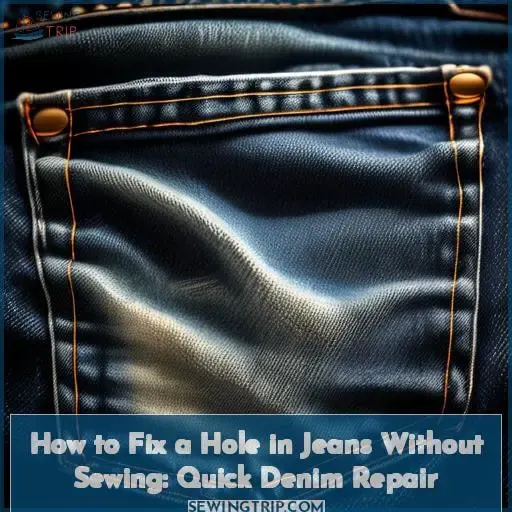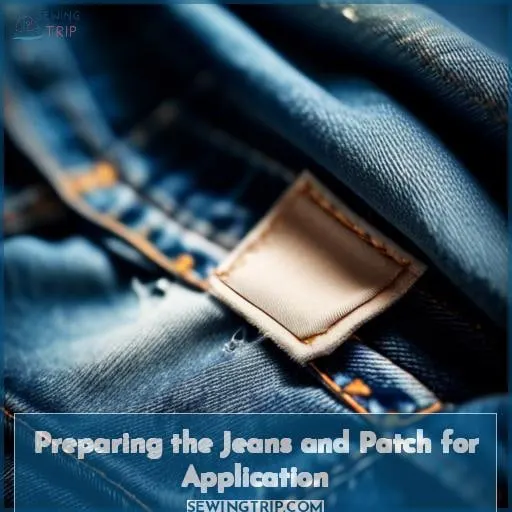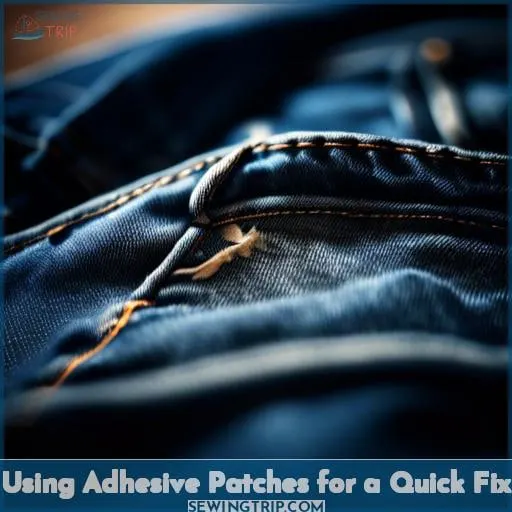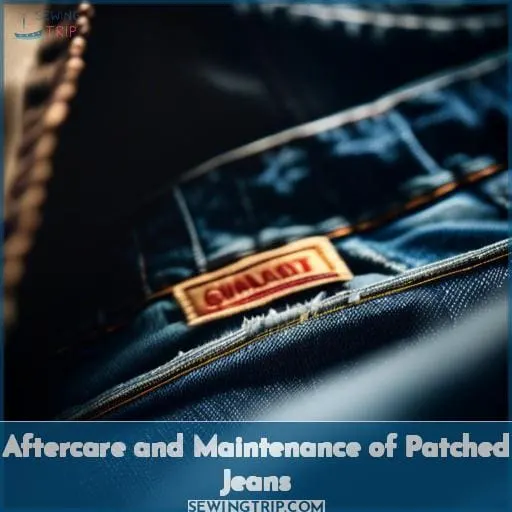This site is supported by our readers. We may earn a commission, at no cost to you, if you purchase through links.
 Struggling with a hole in your favorite denim? Don’t fret—you can fix your jeans without a single stitch! Whether it’s a tiny tear or a gaping hole, a clever patch-up can bring them back to life.
Struggling with a hole in your favorite denim? Don’t fret—you can fix your jeans without a single stitch! Whether it’s a tiny tear or a gaping hole, a clever patch-up can bring them back to life.
Dive into the art of quick denim repair and master the skill of mending without sewing. You’ll learn how to assess the damage, choose the right patch, and apply it with ease for a durable fix.
Keep your cherished jeans in rotation with these savvy solutions for a seamless restoration.
Yes, you can fix a hole in jeans without sewing by using iron-on fabric patches, iron-on tape, or fabric glue for a quick and durable repair.
Table Of Contents
Key Takeaways
- Use fabric glue or iron-on patches for a no-sew solution to repair holes in jeans, ensuring the patch matches the denim color and texture for a seamless look.
- Clean the jeans and patch before application to ensure a strong bond, and consider using a thin layer of fabric glue around the hole edges for extra durability.
- For a quick fix, adhesive patches can be applied with firm pressure, but avoid high-heat washes and tumble drying to maintain the patch’s integrity.
- After repairing, turn jeans inside out before washing, use cold water and a gentle cycle, and air dry to prolong the life of the patched area.
Assessing the Damage and Choosing the Right Patch
When you notice a hole in your favorite pair of jeans, the first step is to assess the damage. Check the size and location of the tear to understand the extent of the repair needed.
Next, choose a patch material that closely matches your denim for a discreet fix, and don’t forget to trim any frayed edges around the hole to prepare for a clean repair.
This initial evaluation and preparation are crucial for a successful, no-sew denim mend.
Assess Damage Size
To assess the damage size on your jeans, first consider the hole size; is it a tiny puncture or a gaping tear? This will influence your repair cost and whether you opt for a temporary or permanent repair.
For visible or hidden holes, aesthetic considerations come into play. If the hole is in a conspicuous area, you might prefer a patch that blends seamlessly.
Patch Material Choice
When choosing a patch for denim repair, consider fabric durability and texture compatibility to ensure a seamless fix.
Opt for a patch that closely matches the color of your jeans for a discreet repair, or select a contrasting shade for a bold statement.
Trim any frayed edges around the hole before applying the patch to create a clean base for placement.
Trim Frayed Edges
Once you’ve picked the perfect patch material, it’s crucial to tackle those frayed edges before applying your patch. Here’s how to ensure a smooth, lasting repair on your jeans without a single stitch.
Start by carefully trimming any frayed threads around the hole. Choose sharp, high-quality scissors for precision—fabric scissors are ideal for this task.
Next, consider reinforcing the edges with fabric glue for added durability. A thin application around the perimeter of the hole creates a barrier against fraying. If you’re using a denim patch, trimming its edges on the bias (diagonally) can also reduce fraying, as this technique naturally resists unraveling.
For an extra safeguard, applying an anti-fray product to both the jeans and the patch edges offers additional fraying prevention. This approach not only neatens the repair area but also strengthens the bond between the patch and the jeans, ensuring your repair stands the test of time.
Preparing the Jeans and Patch for Application
Now that you’ve pinpointed the perfect patch for your denim dilemma, it’s time to prep for the transformation.
Begin by giving your jeans a good clean; any dirt or oils can weaken the adhesive’s grip.
Next, carefully position your patch, eyeing the area with a craftsman’s precision. It’s not just about covering the hole; it’s about integrating the patch seamlessly with the existing fabric.
Crank up your iron to the cotton setting, typically the hottest, to ensure the patch bonds like it’s always been part of your beloved jeans.
Using Adhesive Patches for a Quick Fix
After preparing your jeans and patch, it’s time to dive into the world of adhesive patches for a swift and effective repair. Opting for an adhesive patch is like choosing a trusty sidekick in your denim rescue mission.
First off, patch selection is crucial. Look for a patch that not only matches the color and texture of your jeans but also promises patch durability to withstand future adventures.
Before application, ensure both the jeans and patch are clean—any stain removal should be done beforehand to avoid sealing in dirt. Now, for the application technique: position the patch precisely over the damaged area, ensuring it fully covers the hole or tear.
With the patch in place, apply firm pressure to bond it securely to the fabric. This step is vital for ensuring the patch adheres well and blends seamlessly with your beloved denim.
Applying Iron-on Patches for Durability
When you’re aiming for a repair that stands the test of time, iron-on patches are your go-to.
First, ensure your jeans are prepped and the patch is sized right, with a bit of seam allowance for a secure fit.
Crank up your iron to the appropriate heat setting—no steam, please—as a hot, dry press activates the adhesive for a firm hold.
Place your patch, considering fabric texture and the patch’s placement for a natural look. Cover it with a thin cloth to protect against direct heat, then press down firmly, moving in circles to bond every inch.
After ironing, let it cool to solidify the union. With proper aftercare, avoiding high-heat washes and tumble drying, your patch could last years, keeping your denim in the game.
Aftercare and Maintenance of Patched Jeans
Once you’ve applied an iron-on patch to your jeans, ensuring its longevity is all about proper aftercare. To maintain the patch’s durability and the fabric’s preservation, you’ll need to follow specific wash care guidelines.
Always turn your jeans inside out before washing to protect the patch and prevent further fraying. Opt for cold water and a gentle cycle to safeguard the denim’s integrity and avoid color fading. Using a mild detergent can contribute to stain prevention and keep your jeans looking their best.
When it comes to drying, resist the temptation to throw your jeans in the dryer. High heat can weaken the adhesive bond of the patch and cause shrinkage. Instead, lay your jeans flat or hang them to air dry. This method not only extends the repair longevity but also contributes to fabric preservation.
In between washes, spot cleaning can be a lifesaver. Address spills and stains promptly to prevent them from setting in. If you’re dealing with a stubborn spot, a diluted detergent solution gently applied with a soft cloth can do the trick without compromising the patched area.
Frequently Asked Questions (FAQs)
Can I use a fabric glue instead of an iron-on or adhesive patch for repairing holes in jeans, and if so, how does it affect the durability and flexibility of the repair?
Fabric glue can indeed mend your jeans, offering a flexible, machine-washable fix that’s less durable than sewing but quicker and simpler.
Ensure the glue and patch can bend with the denim.
How can I repair a hole in jeans located in a challenging area, such as the crotch or along a seam, where applying a patch might be difficult?
Despite the tricky location, you can still mend a hole in the crotch or seam of your jeans.
Apply fabric glue around the hole’s edges, press a denim patch firmly over it, and let it dry.
Is it possible to repair a hole in jeans in a way that makes the repair invisible or at least less noticeable, especially for dark denim?
To subtly mend dark denim, use iron-on patches inside the jeans. Color-matched threads should be used to hand-stitch, blending the repair with the fabric’s original texture.
Can I use materials other than denim for patches when fixing holes in jeans, and how do I choose a material that complements the original denim aesthetically and functionally?
To choose materials for patches when fixing jeans, consider iron-on denim patches, scrap fabric, strong thread, a needle, an iron, and a thimble.
Cut the fabric slightly larger than the hole, secure it behind the hole, trim excess fabric.
Attach the patch with an iron and reinforce with hand sewing for durability.
After repairing a hole in jeans without sewing, how should I wash the jeans to ensure the longevity of the repair, and are there any specific care instructions to follow?
To wash jeans after repairing a hole without sewing, turn them inside out before washing to protect the patch.
Use cold water and a gentle cycle to prevent damage.
Avoid using harsh detergents or bleach to maintain the repair’s longevity.
Conclusion
With a touch of finesse, you’ve navigated the delicate task of mending your jeans, sidestepping the need for traditional sewing.
Now, as you stand back and admire your handiwork, remember that the key to longevity is in the aftercare. Treat your newly patched denim with the same care you’d a cherished garment, and you’ll find that your quick fix can withstand the test of time.
Embrace this newfound knowledge on how to fix a hole in jeans without sewing, and wear your revitalized jeans with pride, knowing that a stitch in time isn’t always necessary for saving nine.











